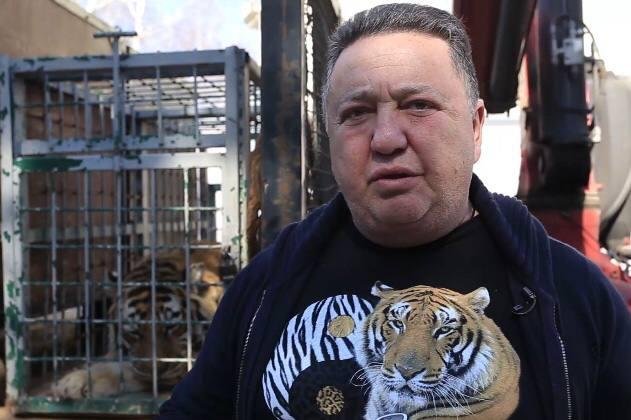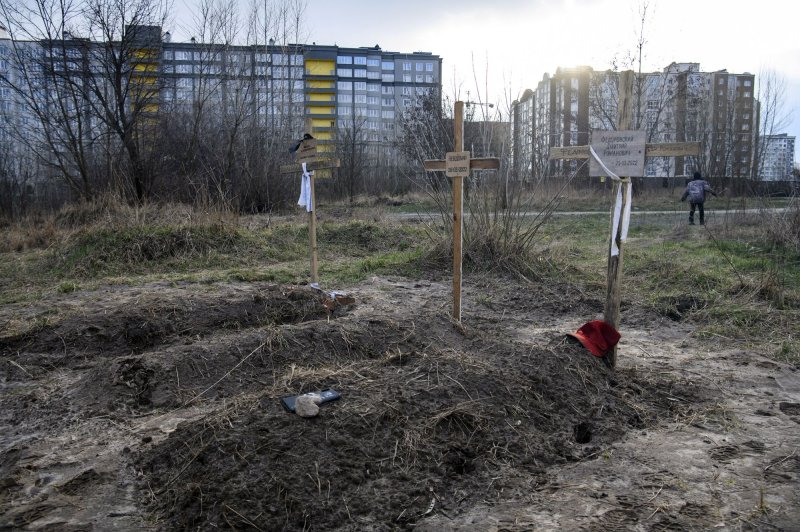
Alexander Feldman, founder of the Feldman Ecopark in Kharkiv, Ukraine, has been working to evacuate animals from his zoo since Russia invaded the Eastern European country early this month. Photo courtesy of Feldman Ecopark
April 12 (UPI) -- Officials at a zoo in the besieged northeastern Ukrainian city of Kharkiv said they're attempting to evacuate large predators from the facility amid Russian shelling.
Five large lions, a cub and a jaguar were among those evacuated from Feldman Ecopark on Monday, but officials said Tuesday represents a "decisive day" in the struggle to save the dangerous animals from the war as they will attempt to remove five bears and three tigers from the facility.
"If the situation with shelling allows, the rescue of the predators will be over," the zoo said.
The zoo began to remove large predators from the territory of the park early this month after Russian shelling destroyed enclosures and critical infrastructure. Alexander Feldman, the zoo's founder, told UPI in an email Tuesday that nearly 100 of its animals have been killed in the war, including nine red deer, two orangutans and a chimpanzee as well as four fallow deer, two bison, three welsh goats and "a large number of big cats."
Three staff members were also killed in the shelling and two have gone missing, he said.

Photo courtesy of Feldman Ecopark
The entire 140-acre park that houses about 5,000 animals of 300 species has been affected by the war with enclosure infrastructure, its recreation area and administrative buildings all but destroyed.
Part of its internal roads have also been littered with unexploded shells and rockets, making it difficult to estimate the extent of the damage, explained Feldman, who had earlier this month declared that "Feldman Ecopark no longer exists" and that getting large predators out was now their greatest concern.
"Their enclosures miraculously still retain their integrity, but one more shelling -- and the lions, tigers, bears, distraught with fear, may be free and go toward Kharkov or to nearby villages," Feldman said in the early March statement. "We cannot allow this."
The operation to evacuate animals from the facility is a complex and dangerous multi-stage process that requires considerable effort and time.
Each animal is transported via a medium-sized truck as anything larger would be a target for drone strikes and they can't stay on the property more than a few hours.
In total, 40% of the animals have been relocated so far with more than a thousand still needing to be evacuated, Feldman said.
"We will not give up, because the humane treatment of animals is what makes us human."
Over the weekend, the park posted to its website a video of three men seen attempting to move a sedated white lion into what appears to be a metal transport container.
In a separate post, it said it evacuated cheetahs from their aviary shortly before it was destroyed in a bombing. If officials had waited any longer, the animals could have been killed or escaped, creating not only a dangerous situation for the felines but for the humans who find them, it said.
"Now they are doing well: They began to settle in their temporary dwelling near Poltava," the statement said.
If the officials are successful in evacuating the last of the large predators from the park, zoo officials said they will begin to remove camels, Siberian ibex, markor and other large hoofed animals to safety.
"We work to save them every day and not a single animal will be left to their fate, be it a pig, a tiger or a bear," it said. "Our team has a firm mood: We will not abandon anyone. All animals will be saved."
In a statement on Monday, the zoo said nearly 4,000 people over the past week alone have provided assistance for the evacuation, treatment and supply of food to Feldman Ecopark animals with donations coming in from all regions of Ukraine, as well as foreign nations, with some large donations being made anonymously in cryptocurrencies.
The mayors of cities, animal protection organizations and those who own small zoos or farms have also reached out to Feldman Ecopark, offering to house animals evacuated from Ukraine, but the park said it prefers to try and keep the animals in the country.
Park director Vitaly Ilchenko selects where the animals will be housed based on logistics, including feed delivery and veterinary services, while attempting to minimize the time they spend in cages for transport as it compounds the stress the animals are under from the Russian bombing.
However, Feldman Ecopark is not the only zoo threatened by the war Russia launched against Ukraine on Feb. 24.
The European Association of Zoos and Aquariums on its website states funds have been given to zoos in the cities of Kharkiv, Kyiv, Lutsk and Mykolaiv, as well as to the Askania Nova biosphere reserve, Odessa Biopark and Rivne Zoo, among others.
Between the start of the war and Tuesday, the EAZA said it has raised more than $1.1 million for the Ukrainian animals from 101 of its member and other institutions and more than 10,400 individual donors.
The organization said the Russian invasion presents unique problems for Ukrainian zoos and animals reserves while Russian forces and sanctions limit options available to aid them.
Its funding protocol has been divided into three phases that are dictated by the progress of the war
During Phase 1: Primary crisis phase, the current phase, the goal is to provide funds to zoos so to cover food and water and other primary care for their animals while helping to move them to safety if possible.
For Phase 2: Secondary crisis phase, the EAZA will need to consider whether the war will persist and if so, provide the facilities with funds for long-term care.
Phase 3: Recovery phase will be initiated once the war is over or fighting is confined to areas away from zoos. Then, money will be dispersed to facilities to rebuild.
The war that nears two months old came under swift condemnation from not only world leaders but animal rights groups and organizations as well.
The World Association of Zoos and Aquariums issued a statement in mid-March warning that the "escalating and indiscriminate violence" of the Russian side included attacks against zoos and their staff, damaging their ability to provide welfare to animals in their care.
"In the spirit of world peace, WAZA calls on its members to immediately cease partnering with the Russian Federation's government and to restrict collaboration with Russian members to specific conservation and animal welfare efforts," it said.
Feldman told UPI that the sooner the war ends the sooner the park will start to rebuild.
"The evacuated animals are with our partners, and we will be able to return to them the park," he said.
But in the meantime, the park will require all the assistance from the international community it can get, he said.
"We need help and support," he said.








 Pierre-Joseph Proudhon circa 1862
Pierre-Joseph Proudhon circa 1862
